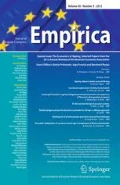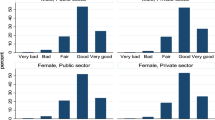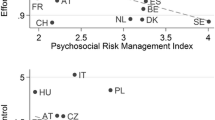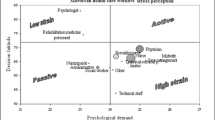Abstract
Worker perceptions of job-related health risk are a little-studied dimension of heterogeneity in the labour market. According to information from the European Working Conditions Survey (EWCS), one out of three European workers considers that her health and safety is at risk because of work. Not surprisingly, risk perceptions are influenced by objective risk factors such as hazardous working conditions, onerous job characteristics and by the probability to be affected by occupational accidents and illnesses. This paper explores also the role played by personal characteristics and household structure for the explanation of risk perceptions. After controlling for job characteristics, workplace hazards, job satisfaction and health outcomes, I find that risk perceptions are strongly correlated with gender, age, and household structure. Lone parents as well as older and more experienced workers have a higher propensity than other categories to consider their health at risk because of work. The same seems to hold true for better educated workers, especially for those who have completed tertiary education. Further results suggest that the relationship between household structure and risk perception is stable across gender.

Similar content being viewed by others
Notes
Another instance is represented by the fact that the majority of drivers tend not to equate their own traffic risk with that of the average person, because they believe themselves to be more skilful and safer than average (see Matthews and Moran 1986).
For a synthetic overview see Bouyer et al. (2001).
The exact wording of the question is: “Do you think that your health and safety is at risk because of your work?”.
I have constructed variables for different household typologies, accounting for the presence of children below the age of 18 and differentiating between singles, couples without children, families and lone parents.
Each dummy variable takes the value of 1 if the respondent stated that he or she is exposed to the condition “around half of the time” or more, and of 0 otherwise.
Although the table displays three aggregated age cohorts, the age variables included in the model are expressed in years. In order to construct the household variables, dependents up to the age of 18 who live with one or both of their parents were counted as children. The educational dummies are based on the international ISCED classification.
A comparison with the third wave of the EWCS, where only the EU15 were surveyed, shows that this share has remained virtually unchanged between 2000 and 2005 (see European Foundation 2005).
This calculation includes Romania and Bulgaria among the new EU member states, although technically they were not part of the Union at the moment when the survey was carried out.
According to the statistical agency of the European Union, in 2005 the incidence rate of deadly work accidents for every 100,000 workers was 2.3 in the EU15 and 2.6 in the EU27.
I present the results in this form because it corresponds to the regression output provided by STATA to zero-inflated count data models.
On the other hand, it cannot be entirely ruled out that the observed variables fail to account fully for gender differences in occupational sorting, i.e. for the fact that women might sort into safer jobs even when they work in the same industry and occupation as men and are exposed to similar working conditions.
Since the difference between actual and predicted risk perception lies in the range between −1 and 1, I implement the following transformation: When the difference (i.e. predicted value minus actual value) is larger than 0.5 I assume that there is a low risk perception on the part of the individual; when the difference is below −0.5 I assume a high risk perception; values between −0.5 and 0.5 represent the baseline of the subsequent analysis, as I assume that the individual response coincides with what is predicted by the model.
In this specification I do not include any other control variables. Inclusion of control variables (country, industry, occupation and firm size) and of the variables for personal characteristics and satisfaction leads to results which are almost identical to those displayed in Table 4. I take this as evidence that results are robust to different specifications and transformations of the information on working conditions and job characteristics.
References
Akerlof GA, Dickens WT (1982) The economic consequences of cognitive dissonance. Am Econ Rev 72(3):307–319
Barone A, Nese A (2003) On the job health risks: workers’ beliefs and individual work experiences. Giornale degli Economisti e Annali di Economia 62(1):125–144
Bender KA, Mridha HA, Peoples J (2006) Risk compensation for hospital workers: evidence from relative wages of janitors. Ind Labor Relat Rev 59(2):226–242
Böckerman P, Ilmakunnas P (2006) Do job disamenities raise wages or ruin job satisfaction? Int J Manpow 27(3):290–302
Bouyer M, Bagdassarian S, Chaabanne S, Mullet E (2001) Personality correlates of risk perception. Risk Anal 21(3):457–465
Case A, Paxson C (2005) Sex differences in morbidity and mortality. Demography 42(2):189–214
Davidson DJ, Freudenburg WR (1996) Gender and environmental concerns: a review and analysis of available research. Environ Behav 28:302–339
DeLeire T, Levy H (2004) Worker sorting and the risk of death on the job. J Labor Econ 22(4):925–953
Delgado MA, Kiesner TJ (1997) Count data models with variance of unknown form: an application to a hedonic model of worker absenteeism. Rev Econ Stat 79(1):41–49
Dionne G, Dostie B (2008) New evidence on the determinants of absenteeism using linked employer-employee data. Ind Labor Relat Rev 61(1):108–120
Dionne G, Fluet C, Desjardins D (2007) Predicted risk perception and risk-taking behaviour: the case of impaired driving. J Risk Uncertain 35:237–264
Elliott RF, Sandy R (1998) Adam Smith may have been right after all: a new approach to the analysis of compensating differentials. Econ Lett 59:127–131
European Foundation for the Improvement of Living and Working Conditions (2005) Third European Working Conditions Survey 2000, Dublin
European Foundation for the Improvement of Living and Working Conditions (2007a) Quality report of the 4th European Working Conditions Survey, Dublin
European Foundation for the Improvement of Living and Working Conditions (2007b) Fourth European Working Conditions Survey 2005, Dublin
Fischhoff B, Slovic P, Lichtenstein S, Read S, Combs B (1978) How safe is safe enough? A psychometric study of attitudes towards technological risks and benefits. Policy Sci 8:127–152
Frick B, Malo MA (2008) Labour market institutions and individual absenteeism in the European Union. Ind Relat 47(4):505–529
Gaba W, Viscusi WK (1998) Differences in subjective risk thresholds: worker groups as an example. Manage Sci 44(6):801–811
Garen J (1988) Compensating wage differentials and the endogeneity of job riskiness. Rev Econ Stat 70(1):9–16
Grazier S, Sloane PJ (2008) Accident risk, gender, family status and occupational choice in the UK. Labour Econ 15(5):938–957
Gustafson E (1998) Gender differences in risk perception: theoretical and methodological perspectives. Risk Anal 18(6):805–811
Hakes JK, Viscusi WK (2004) Dead reckoning: demographic determinants of the accuracy of mortality risk perceptions. Risk Anal 24(3):651–664
Hsee CK, Weber EU (1998) Cross-cultural differences in risk perception, but cross-cultural similarities in attitudes towards perceived risk. Manage Sci 44(9):1205–1214
Johnson E, Tversky A (1984) Representations of perceptions of risks. J Exp Psychol 113(1):55–70
Lalive R (2003) Did we overestimate the value of health? J Risk Uncertain 27(2):171–193
Leeth JD, Ruser J (2003) Compensating wage differentials for fatal and nonfatal injury risk by gender and race. J Risk Uncertain 27(3):257–277
Lichtenstein S, Slovic P, Fishhoff B, Layman M, Combs B (1978) Judged frequency of lethal events. J Exp Psychol Hum Learn Mem 4(6):551–578
Lundborg P, Lindgren B (2004) Do they know what they are doing? Risk perceptions and smoking behaviour among Swedish teenagers. J Risk Uncertain 28(3):261–286
Matthews ML, Moran AR (1986) Age differences in male drivers perception of accident risk: the role of perceived driving abilities. Accid Anal Prev 18(4):299–313
Robertson V, Stewart T (2004) Risk perception in relation to musculoskeletal disorders. Health & Safety Executive, London
Sarin RK, Weber M (1993) Risk-value models. Eur J Oper Res 70(2):135–149
Savage I (1993) An empirical investigation into the effect of psychological perceptions on the willingness-to-pay to reduce risk. J Risk Uncertain 6(1):75–90
Sjöberg L (2000) Factors in risk perception. Risk Anal 20(1):1–11
Sjöberg L, B-E Moen, T Rundmo (2004) Explaining risk perception. An evaluation of the psychometric paradigm in risk perception research, Rotunde, 84, Norwegian University of Science and Technology, Trondheim
Slovic P, Fischhoff B, Lichtenstein S (1982) Why study risk perceptions? Risk Anal 2(2):83–93
Slovic P, Fischhoff B, Lichtenstein S (1985) Characterizing perceived risk. In: Kates RW, Hohenemser C, Kasperson J (eds) Perilous progress: managing the hazards of technology. Westview, Boulder, pp 91–125
Viscusi WK (1989) Prospective reference theory: toward an explanation of the paradoxes. J Risk Uncertain 2:235–264
Viscusi WK (1990) Sources of inconsistency in societal responses to health risks. Am Econ Rev 80(2):257–261
Viscusi WK, Hakes JK (2008) Risk beliefs and smoking behavior. Econ Inq 46(1):45–59
Weber EU, Millman R (1997) Perceived risk attitudes: relating risk perception to risky choice. Manage Sci 43:122–143
Winkelmann R (1999) Wages, firm size and absenteeism. Appl Econ Lett 6(6):337–341
Acknowledgments
I would like to thank René Böheim, Martin Falk and Andrea Weber as well as two anonymous referees for very useful comments to earlier drafts of this article. Responsibility for the final product lies entirely with me. I am also grateful to participants of the NoeG 2009 conference in Linz for their comments and to the European Foundation for the Improvement of Living and Working Conditions for providing the EWCS data.
Author information
Authors and Affiliations
Corresponding author
Appendices
Appendix 1
See Table 5.
Appendix 2
See Table 6.
Appendix 3
3.1 Principal component analysis
Rights and permissions
About this article
Cite this article
Leoni, T. What drives the perception of health and safety risks in the workplace? Evidence from European labour markets. Empirica 37, 165–195 (2010). https://doi.org/10.1007/s10663-010-9129-0
Published:
Issue Date:
DOI: https://doi.org/10.1007/s10663-010-9129-0





